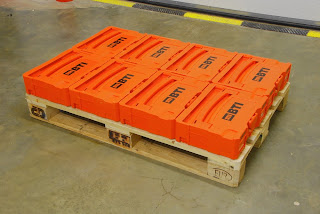
My first impression of systainers was something along the lines of ‘that’s a lot of money for a box’ and I suspect that many others will have had the same thoughts. However, the people I have spoken to who actually use them absolutely rave about them, so I thought it was time to dig a little deeper and find out what all the fuss is about. Suffice to say that having sated my curiosity, I now count myself amongst the legion of fans who believe that they are actually a remarkable amount of box for the money! I don't want to make this a bullet point list of specifications, that's not really our style, but I would like to explain some of the considerable research and thought that has gone into the design.
Systainers are made by German company TANOS GmbH which was formed in 1993 as a subsidiary of Tooltechnic Systems (which is also the parent company of Festool) specifically to develop and market the systainer range of products. Since then they have supplied over 14 million of them to companies including Bosch, Festool, Makita, Mafell and of course BTI.
The word ‘systainer’ is a composite of ‘system’ and ‘container’, the system part is the clever bit. Because it is a complete system you get all the efficiency benefits of working in a neatly organised workshop, but because it is portable, you can take that same level of efficiency anywhere. The boxes can be connected, so you can lock them together to form a stack, which can then be picked up by the integral handle or transported using a trolley or roller board to your place of work. Lockable safes with full extension drawer runners are also available that can be bolted into a vehicle or building to store your systainers securely without restricting your access to the contents. For the insides of the boxes, a wide range of inserts are available to keep the contents neatly organised.

The boxes themselves are made from high quality ABS with geometric reinforcement, so they are strong and stiff but also very light. The components are available individually, so if you damage a small part like a hinge or a lock, you can often just replace the component – not the whole box.
The boxes come in two main types.
Classic systainers have four tabs which can either lock the lid in place or reach up a little further to both secure the lid and hold another systainer on top. The classic range is more fully developed so there are a wider range of options available. The maxi systainer has twice the footprint (60cm x 40cm) of a standard systainer so you can attach a double stack of standard systainers (either classic or T-Loc) on top of it.
Mini systainers only stack with each other, but drop a foam insert into the bottom of a standard systainer and two stacks of minis will fit in perfectly side by side. There are also lockable systainers, insulated systainers and sortainers with built in sub-dividable drawers. I was surprised to find that you can fit a full set of 12 bevel edged chisels in a tool roll, with a mallet, into the large drawer of a four drawer sortainer and still have room to spare.

The newer T-Loc systainers fasten together like a French cleat, and are then locked into place with the single T shaped locking device on the front. The T-loc’s have several advantages in that they are much faster to use, can be fastened with one hand and (as long as the boxes above are not too heavy) allow boxes to be opened in the middle of a stack. T-Locs are available in five depths.

T loc systainers have the same attachment lugs around the bottom as classics, so you can stack T-locs on top of classics but not the other way around.
The internal shape of the two types is different too, so the inserts that go with them are type specific.
Both classics and T-Locs have the same size footprint – about 30cm x 40cm. This size was arrived at because it is one eighth of a standard europallet, which makes systainers suitable for palletised loads as well as keeping distribution costs down.

There's a lot of information to cover on this product range. In systainer explainer Part 2 we will look at some of the possible adaptations that can be made to the interior of the boxes.






Hi Matthew,
ReplyDeleteI'm interested in the last photo asstainer.
Do you sell also it?
:-)